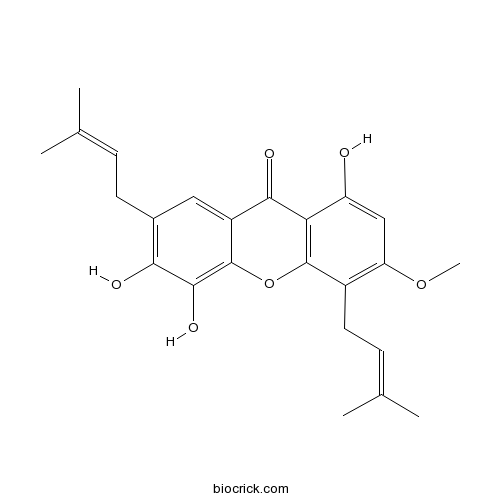Parvifolixanthone BCAS# 906794-57-8 |

Quality Control & MSDS
3D structure
Package In Stock
Number of papers citing our products

| Cas No. | 906794-57-8 | SDF | Download SDF |
| PubChem ID | 16085281 | Appearance | Powder |
| Formula | C24H26O6 | M.Wt | 410.46 |
| Type of Compound | Xanthones | Storage | Desiccate at -20°C |
| Solubility | Soluble in Chloroform,Dichloromethane,Ethyl Acetate,DMSO,Acetone,etc. | ||
| Chemical Name | 1,5,6-trihydroxy-3-methoxy-4,7-bis(3-methylbut-2-enyl)xanthen-9-one | ||
| SMILES | CC(=CCC1=C(C(=C2C(=C1)C(=O)C3=C(O2)C(=C(C=C3O)OC)CC=C(C)C)O)O)C | ||
| Standard InChIKey | RATPZJKZEAONEQ-UHFFFAOYSA-N | ||
| Standard InChI | InChI=1S/C24H26O6/c1-12(2)6-8-14-10-16-21(27)19-17(25)11-18(29-5)15(9-7-13(3)4)23(19)30-24(16)22(28)20(14)26/h6-7,10-11,25-26,28H,8-9H2,1-5H3 | ||
| General tips | For obtaining a higher solubility , please warm the tube at 37 ℃ and shake it in the ultrasonic bath for a while.Stock solution can be stored below -20℃ for several months. We recommend that you prepare and use the solution on the same day. However, if the test schedule requires, the stock solutions can be prepared in advance, and the stock solution must be sealed and stored below -20℃. In general, the stock solution can be kept for several months. Before use, we recommend that you leave the vial at room temperature for at least an hour before opening it. |
||
| About Packaging | 1. The packaging of the product may be reversed during transportation, cause the high purity compounds to adhere to the neck or cap of the vial.Take the vail out of its packaging and shake gently until the compounds fall to the bottom of the vial. 2. For liquid products, please centrifuge at 500xg to gather the liquid to the bottom of the vial. 3. Try to avoid loss or contamination during the experiment. |
||
| Shipping Condition | Packaging according to customer requirements(5mg, 10mg, 20mg and more). Ship via FedEx, DHL, UPS, EMS or other couriers with RT, or blue ice upon request. | ||
| Description | Parvifolixanthone B is a natural product from Garcinia parvifolia. |
| Structure Identification | Tetrahedron, 2006, 62(36):8578-8585.Phloroglucinols, depsidones and xanthones from the twigs of Garcinia parvifolia.[Reference: WebLink]
|

Parvifolixanthone B Dilution Calculator

Parvifolixanthone B Molarity Calculator
| 1 mg | 5 mg | 10 mg | 20 mg | 25 mg | |
| 1 mM | 2.4363 mL | 12.1815 mL | 24.3629 mL | 48.7258 mL | 60.9073 mL |
| 5 mM | 0.4873 mL | 2.4363 mL | 4.8726 mL | 9.7452 mL | 12.1815 mL |
| 10 mM | 0.2436 mL | 1.2181 mL | 2.4363 mL | 4.8726 mL | 6.0907 mL |
| 50 mM | 0.0487 mL | 0.2436 mL | 0.4873 mL | 0.9745 mL | 1.2181 mL |
| 100 mM | 0.0244 mL | 0.1218 mL | 0.2436 mL | 0.4873 mL | 0.6091 mL |
| * Note: If you are in the process of experiment, it's necessary to make the dilution ratios of the samples. The dilution data above is only for reference. Normally, it's can get a better solubility within lower of Concentrations. | |||||

Calcutta University

University of Minnesota

University of Maryland School of Medicine

University of Illinois at Chicago

The Ohio State University

University of Zurich

Harvard University

Colorado State University

Auburn University

Yale University

Worcester Polytechnic Institute

Washington State University

Stanford University

University of Leipzig

Universidade da Beira Interior

The Institute of Cancer Research

Heidelberg University

University of Amsterdam

University of Auckland

TsingHua University

The University of Michigan

Miami University

DRURY University

Jilin University

Fudan University

Wuhan University

Sun Yat-sen University

Universite de Paris

Deemed University

Auckland University

The University of Tokyo

Korea University
- Parvifolixanthone A
Catalog No.:BCN7354
CAS No.:906794-56-7
- AN-2728
Catalog No.:BCC1361
CAS No.:906673-24-3
- Teneligliptin hydrobromide
Catalog No.:BCC1992
CAS No.:906093-29-6
- Neochlorogenic acid
Catalog No.:BCN4450
CAS No.:906-33-2
- CGK733
Catalog No.:BCC3911
CAS No.:905973-89-9
- Isopsoralenoside
Catalog No.:BCN3197
CAS No.:905954-18-9
- Psoralenoside
Catalog No.:BCN3196
CAS No.:905954-17-8
- Scutebarbatine B
Catalog No.:BCN4449
CAS No.:905929-95-5
- Tivantinib (ARQ 197)
Catalog No.:BCC3688
CAS No.:905854-02-6
- Sorghumol acetate
Catalog No.:BCN4448
CAS No.:90582-47-1
- Sorghumol
Catalog No.:BCN4447
CAS No.:90582-44-8
- AZ 960
Catalog No.:BCC2197
CAS No.:905586-69-8
- SCH 546738
Catalog No.:BCC4110
CAS No.:906805-42-3
- Methyl 1,4-bisglucosyloxy-3-prenyl-2-naphthoate
Catalog No.:BCN7597
CAS No.:90685-26-0
- 5-Hydroxysophoranone
Catalog No.:BCN6842
CAS No.:90686-12-7
- Ethyl beta-carboline-1-propionate
Catalog No.:BCN1311
CAS No.:90686-24-1
- (S)-4-Benzyl-2-oxazolidinone
Catalog No.:BCC8401
CAS No.:90719-32-7
- Musellactone
Catalog No.:BCN7183
CAS No.:907583-51-1
- Atosiban
Catalog No.:BCC5314
CAS No.:90779-69-4
- 6,8-Di-O-methylcitreoisocoumarin
Catalog No.:BCN7380
CAS No.:908098-80-6
- SNX-2112
Catalog No.:BCC2132
CAS No.:908112-43-6
- PF-04929113 (SNX-5422)
Catalog No.:BCC2130
CAS No.:908115-27-5
- Cyclo(Ile-Ala)
Catalog No.:BCN2429
CAS No.:90821-99-1
- Goshonoside F1
Catalog No.:BCN6444
CAS No.:90851-24-4
Phloroglucinols, depsidones and xanthones from the twigs of Garcinia parvifolia.
Tetrahedron, 2006, 62(36):8578-8585.
Seven phloroglucinols, named parvifoliols A–G (1–7), two depsidones, named parvifolidones A, B (8, 9), and three xanthones, named parvifolixanthone A, Parvifolixanthone B, parvifolixanthone C (10–12), were isolated from the twigs of Garcinia parvifolia along with seven known compounds: garcidepsidone B, mangostinone, rubraxanthone, dulxanthone D, 1,3,5,6-tetrahydroxyxanthone, norathyriol, and (2E,6E,10E)-(+)-4β-hydroxy-3-methyl-5β-(3,7,11,15-tetramethylhexadeca-2,6,10,14-tetraenyl)cyclohex-2-en-1-one. Their structures were proposed on the basis of spectroscopic data. The antibacterial and antioxidation activities were evaluated.


